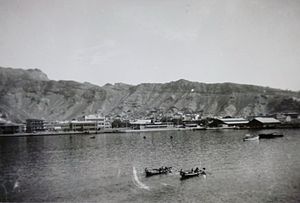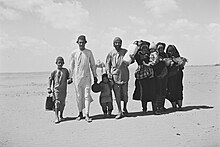1947 anti-Jewish riots in Aden: Difference between revisions
Rescuing 1 sources and tagging 0 as dead. #IABot (v1.4beta) |
|||
| Line 45: | Line 45: | ||
===United Nations' vote on Palestine=== |
===United Nations' vote on Palestine=== |
||
{{main|United Nations Partition Plan for Palestine}} |
{{main|United Nations Partition Plan for Palestine}} |
||
On 29 November 1947, the [[United Nations General Assembly]] adopted a resolution "recommending to the United Kingdom, as the mandatory Power for Palestine, and to all other Members of the United Nations the adoption and implementation, with regard to the future government of Palestine, of the Plan of Partition with Economic Union", [[1947 UN Partition Plan|UN General Assembly Resolution 181(II)]].<ref>{{cite web |
On 29 November 1947, the [[United Nations General Assembly]] adopted a resolution "recommending to the United Kingdom, as the mandatory Power for Palestine, and to all other Members of the United Nations the adoption and implementation, with regard to the future government of Palestine, of the Plan of Partition with Economic Union", [[1947 UN Partition Plan|UN General Assembly Resolution 181(II)]].<ref>{{cite web|url=http://domino.un.org/unispal.nsf/0/7f0af2bd897689b785256c330061d253 |title=A/RES/181(II) of 29 November 1947 |first= |last= |work=domino.un.org |year=1947 |accessdate=11 January 2012 |deadurl=yes |archiveurl=https://web.archive.org/web/20120524094913/http://domino.un.org/unispal.nsf/0/7f0af2bd897689b785256c330061d253 |archivedate=24 May 2012 |df= }}</ref> This was an attempt to resolve the Arab-Jewish conflict by partitioning [[Mandatory Palestine]] into "Independent Arab and Jewish States and the Special International Regime for the City of Jerusalem". Following the vote by the UN on partition of [[Mandatory Palestine]], wide scale protests took place across the Arab countries and communities, with [[Aden]] being no exception.{{sfn|Parfitt|1996|p=167}} |
||
==The riots== |
==The riots== |
||
Revision as of 00:42, 15 June 2017
| 1947 Aden riots | ||||
|---|---|---|---|---|
| Part of Spillover of the 1947–48 Civil War in Mandatory Palestine | ||||
 Aden from the Port of Aden, 1949 | ||||
| Date | 2–4 December 1947 | |||
| Location | 12°48′N 45°02′E / 12.800°N 45.033°E | |||
| Caused by | Disputes over United Nations Partition Plan for Palestine | |||
| Methods | Rioting, melee attacks | |||
| Parties | ||||
| Casualties and losses | ||||
| ||||
The 1947 Aden riot was a three day riot between Aden's Jewish community and Yemeni Arabs in early December 1947 following the approval of the United Nations Partition Plan for Palestine on 29 November 1947. It was one of the most violent scuffles involving Mizrahi Jewish communities in the Middle East in modern times, resulting in the deaths of 76–82 Jews,[1] 33 Arabs, four Muslim Indians, and one Somali,[2] as well as wide scale devastation of the local Jewish community of Aden.[1]
The riots were a significant embarrassment for the British government, particularly given that the British-raised Aden Protectorate Levies were blamed for causing many unnecessary deaths.[3]
Background
By the mid-20th century, Aden was under British rule (today part of Yemen) and had a community of around 5,000 Jews living alongside the Muslim population.[4][1] In the 1930s, there were rare, religiously motivated outbreaks of anti-Jewish violence and a relatively small riot[4] in May 1932 in which Muslims accused Jews of throwing excrement into a mosque courtyard.[5] Sixty persons, including 25 Jews, were injured but there were no fatalities.[6] The Farhi synagogue was desecrated.[5] In the 1940s, visits of Palestinian Arabs to Aden and expressions of Anti-Jewish sentiments became common.[4] Adenese educated Arab population had become exposed to Egyptian newspapers, as well as radio broadcasts of "Voice of the Arabs" from Cairo, which incited political awareness and prepared the grounds for the anti-Jewish riot of November 1947 and later the 1967 expulsion of the British forces.[4]
United Nations' vote on Palestine
On 29 November 1947, the United Nations General Assembly adopted a resolution "recommending to the United Kingdom, as the mandatory Power for Palestine, and to all other Members of the United Nations the adoption and implementation, with regard to the future government of Palestine, of the Plan of Partition with Economic Union", UN General Assembly Resolution 181(II).[7] This was an attempt to resolve the Arab-Jewish conflict by partitioning Mandatory Palestine into "Independent Arab and Jewish States and the Special International Regime for the City of Jerusalem". Following the vote by the UN on partition of Mandatory Palestine, wide scale protests took place across the Arab countries and communities, with Aden being no exception.[8]
The riots
| Part of a series on |
| Jewish exodus from the Muslim world |
|---|
 |
| Background |
| Antisemitism in the Arab world |
| Exodus by country |
| Remembrance |
| Related topics |
On 2 December, the Arabs of Aden proclaimed a comprehensive three-day solidarity strike.[4][9] Shortly after their beginning, the protests in Aden erupted into a "shameful outbreak of violence" against the Jews.[4] According to the British Governor of the Colony of Aden, Sir Reginald Champion, the rioting after 4 December was triggered by "alleged hostile Jewish activity and killing of an Indian Muslim doctor and a Levy almost certainly by a Jewish sniper of 4th December."[8]
According to a contemporary news account, the rioting began on 2 December, when an Arab crowd converged on the Jewish quarter in Aden's old town. Jewish shops were looted and burned. The rioting resumed the following day, and British army units from the Suez Canal Zone and navy forces were brought in to restore order.[10] The Selim Girls' School in 1929 which was located next to King George V Jewish Boys School and was also gutted in the 1947 riots.[citation needed]
Overall 82 Jews were killed (including 6 unidentified bodies, assumed to be Jews) and 76 wounded.[4] In Crater, 106 Jewish-owned shops were completely looted and 8 more were partially looted (out of total 170), while the only 2 Jewish schools were burnt and some 30 houses, while almost all private Jewish-owned cars were burnt.[4] in Shaykh Uthman, 61 houses were damaged and looted, 12 more houses were burnt; 5 shops, 1 school and 1 synagogue, as well as Jewish-owned distillery were burnt as well.[4]
A subsequent British commission of inquiry found that "trigger happy" firing by Aden Protectorate Levies had resulted in unnecessary casualties of 82 Jews and 38 Arabs.[citation needed] Sir Harry Trusted, who was sent to Aden as Commissioner to investigate the riots, recommended that British troops be permanently stationed there.[11]
Aftermath
The official casualty count was 76–82 Jews (6 persons were unidentified) and 38 Arabs killed, and 76 Jews wounded. At least 87 Arabs were known to have been wounded but many others failed to report their condition. The dead included one Indian Medical Officer and one Levy. More than 100 Jewish shops were looted and 30 houses burned. An official enquiry conducted by Sir Harry Trusted determined that many individual Levies were sympathetic to the rioters and did not act to control them. Nine Levies were imprisoned for looting. Trusted put most of the blame on Yemeni "coolies", workers temporarily in the country who "have a low standard of life, are illiterate, fanatical and, when excited, may be savage."[12] He did not find claims of Jewish sniping to be convincing, though the Governor Reginald Champion secretly reported to the British government that the two military fatalities were killed "almost certainly by Jewish sniper".[9] Jewish leaders acknowledged "many instances of Arabs and Indians sheltering and otherwise befriending their Jewish neighbours."[12] The British government was severely embarrassed by the riots, noting privately that they were urging the Arab states to protect their Jews when they themselves were unable to.[9]
Shortly after the riots, Aden's Jewish community almost entirely emptied, together with most of the Yemeni Jewish community.[citation needed]
See also
References
- ^ a b c Aderet, Ofer (30 November 2016). "Jews of Aden recall the pogrom sparked by UN vote on Palestine partition plan". Haaretz. Retrieved 2 December 2016.
- ^ Parfitt, Tudor (1996), The Road to Redemption: The Jews of the Yemen 1900-1950, Brill's Series in Jewish Studies vol. XVII, ISBN 9789004105447
- ^ Parfitt 1996.
- ^ a b c d e f g h i Ahroni, R. The Jews of the British Crown Colony of Aden: History, Culture, and Ethnic Relations. Brill, 1994: P210-11.
- ^ a b Tudor Parfitt (1996). The Road to Redemption—The Jews of the Yemen 1900-1950. Leiden: E. J. Brill. pp. 128–129.
- ^ Secretary of State for India, House of Commons debates of May 30, 1932 and June 1, 1932. However, John Willis (1997). "Colonial Policing in Aden, 1937-1967". The Arab Studies Journal. 5 (1): 57–91. says there was one fatality.
- ^ "A/RES/181(II) of 29 November 1947". domino.un.org. 1947. Archived from the original on 24 May 2012. Retrieved 11 January 2012.
{{cite web}}: Unknown parameter|deadurl=ignored (|url-status=suggested) (help) - ^ a b Parfitt 1996, p. 167.
- ^ a b c Tudor Parfitt (1996). The Road to Redemption—The Jews of the Yemen 1900-1950. Leiden: E. J. Brill. pp. 165–168.
- ^ "Rioting in Yemen". The Age. Reuters. 8 December 1947. Retrieved 28 December 2013.
- ^ "Inquiry into Aden Riots". The Glasgow Herald. 23 September 1948. Retrieved 28 December 2013.
- ^ a b Harry Trusted (1948). Report of the Commission of Enquiry into Disturbances in Aden, December 1947. Colonial No. 233. London: His Majesty's Stationery Office.
